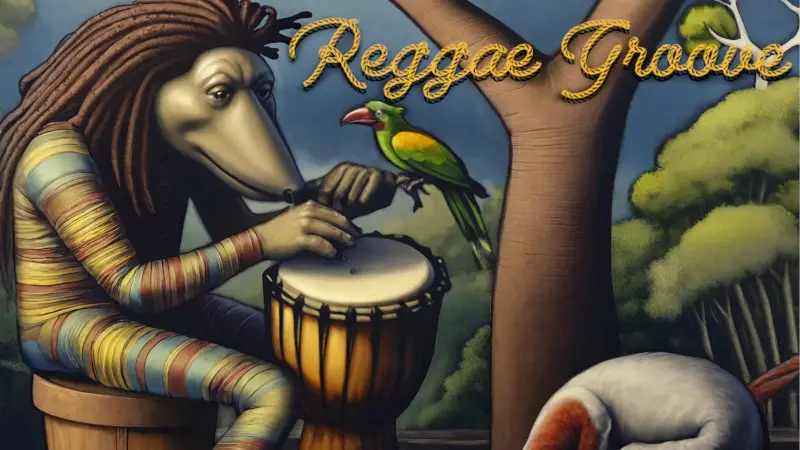
Table of Contents
Introduction: Reggae Instruments Make the Sound
From the laid-back riddims of Bob Marley to the deep dub grooves of King Tubby, reggae has a signature sound that is instantly recognizable. But what gives reggae music its infectious pulse and irie vibe? The answer lies in its distinct array of reggae instruments—each playing a unique role in the sonic tapestry that defines the reggae music genre.
In this comprehensive guide, we’ll explore the essential reggae instruments that bring life to the genre. From traditional roots reggae instrument setups to modern dub gear, you’ll gain a deeper appreciation of how reggae music is built from the ground up, with a keen focus on the specific musical instruments reggae relies upon.
What Are Reggae Instruments?
The fundamental tools used to form the distinctive reggae sound are known as reggae instruments. While many of them—like drums, bass, and guitar—are common in other genres, it’s how they are played in reggae that gives the music its unique groove. These musical instruments reggae are fundamental to the genre’s distinct character and contribute to its signature sound.
Core reggae instruments include:
- Bass guitar
- Drums
- Rhythm (skank) guitar
- Keyboards & organ
- Percussion (congas, bongos, shakers)
- Horns (trumpet, sax, trombone)
- Dub effects (delay, reverb, echo)
- Vocals (as instrument and message)
Each reggae instrument plays a distinct role, often more about feel and space than technical complexity. Let’s dive into each one, exploring how these specific reggae instruments shape the genre’s iconic sound.

The Bass Guitar – Reggae’s Melodic Foundation
In most genres, the bass serves a supporting role—but in reggae, the reggae bass guitar takes the spotlight as arguably the most important of all reggae instruments.
The bass guitar reggae uses is typically deep, heavy, and melodic. It often carries the main hook of the song, locking tightly with the reggae drums to form the “riddim”—the rhythm track that serves as the foundation of a tune. This deep reggae bass provides the grounding for the entire reggae song, demonstrating its crucial role as a core reggae instrument.
Famous bassists like Aston “Family Man” Barrett of The Wailers crafted smooth, rolling bass lines that feel like waves on the ocean—steady, hypnotic, and soulful. His iconic reggae bass lines are a testament to the instrument’s undeniable importance among reggae instruments.
Drums – The Pulse of the People
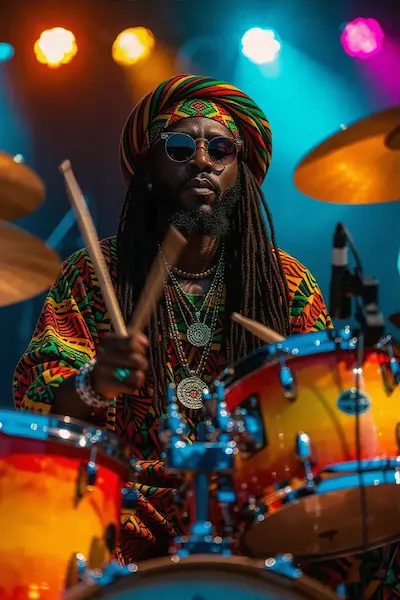
The unique drum rhythms of reggae, especially the well-known One Drop rhythm, are its beating heart.
Drums give reggae its unmistakable sound, which is instantly identifiable and essential to the music.
Typical Drum Styles in Reggae:
- One Drop: Snare/rimshot on beats two and four, kick on beat three.
- Rockers – Straight 4/4 beat with added hi-hat activity.
- Steppers – Kick drum hits all four beats, giving an urgent drive.
The snare or rimshot often accents the second and fourth beats, giving reggae its backbeat feel. The reggae drummer doesn’t overpower; they serve the groove, making the drum kit a foundational reggae instrument that drives the rhythm.
Rhythm Guitar – The Skank that Keeps It Moving
The reggae rhythm guitar, sometimes referred to as the “skank guitar,” plays on the off-beats of 2 and 4 in a 4/4 measure. This specific technique, executed by this particular reggae instrument, creates that laid-back, bounce-forward groove reggae is famous for. The distinct reggae guitar style is crucial for the genre’s feel.
Skank Technique:
- Clean tone
- Quick upstrokes
- Muted or staccato hits
- Minimal distortion
The reggae guitar doesn’t show off—it grooves. It’s all about locking into the beat and complementing the drums and bass. For a truly authentic reggae sound, the skank electric guitar reggae is an indispensable reggae instrument.
Keyboards & Organ – The Bubble and the Stabs
Reggae keys do more than just fill space—they add rhythm and color, making the keyboard a versatile reggae instrument. The reggae keyboard is often understated but essential for the genre’s texture.
Two Key Roles:
- Bubble Organ: A percussive, syncopated rhythm played on a synth or Hammond organ. One characteristic of reggae instruments is this particular use of the organ.
- Chord Stabs – Sharp, off-beat hits that add rhythmic punctuation, often from other keyboard sounds.
The Hammond B3 organ is especially distinctive, bringing warmth and a touch of psychedelia when paired with delay and reverb effects, contributing significantly to the atmosphere of the reggae music genre. It’s a truly iconic reggae instrument.
Percussion – The Roots and the Spirit
Additional percussion in reggae taps into its African and Nyabinghi roots, providing crucial rhythmic layers. These diverse percussion instruments are vital for adding texture and depth to the reggae sound.
Common Percussion Musical Instruments:
- Congas & Bongos
- Shakers & Tambourines
- Nyabinghi Drums (Thunder, Funde, Repeater)
Nyabinghi drumming is tied to Rastafari ceremonies and is a spiritual element of roots reggae, showcasing how each instrument percussion brings a unique cultural and rhythmic contribution to the ensemble of reggae instruments.

Horns – Soulful Melodies & Sharp Punctuations
A reggae horn section brings either smooth melodies or sharp punctuation to a track, adding a rich harmonic dimension. Typical reggae musical instruments for this section include:
- Trumpet
- Trombone
- Saxophone
Horn Roles in Reggae:
- Melodic counter-lines
- Sharp, unison stabs on offbeats or fills
Horns can transform a groove from simple to powerful, especially in ska, roots, and lovers rock, enhancing the overall reggae instrumental sound. The reggae trumpet, reggae trombone, and reggae saxophone are key reggae instruments that add both melody and punch.
Vocals – The Human Instrument
Vocals in reggae are more than lyrics—they’re rhythmic and melodic tools that deliver conscious messages, spiritual insight, or social commentary. While not a traditional physical instrument, the human voice functions as a primary reggae instrument in its own right. Many reggae songs rely heavily on compelling vocal delivery.
Vocal Techniques:
- Call and response
- Layered harmonies
- Toasting (spoken word/Jamaican rap)
Vocal delivery is essential to the emotional and cultural depth of reggae music. It’s how the reggae culture often communicates its profound messages, making the voice a powerful and expressive reggae instrument.
Dub Effects – Studio Becomes an Instrument
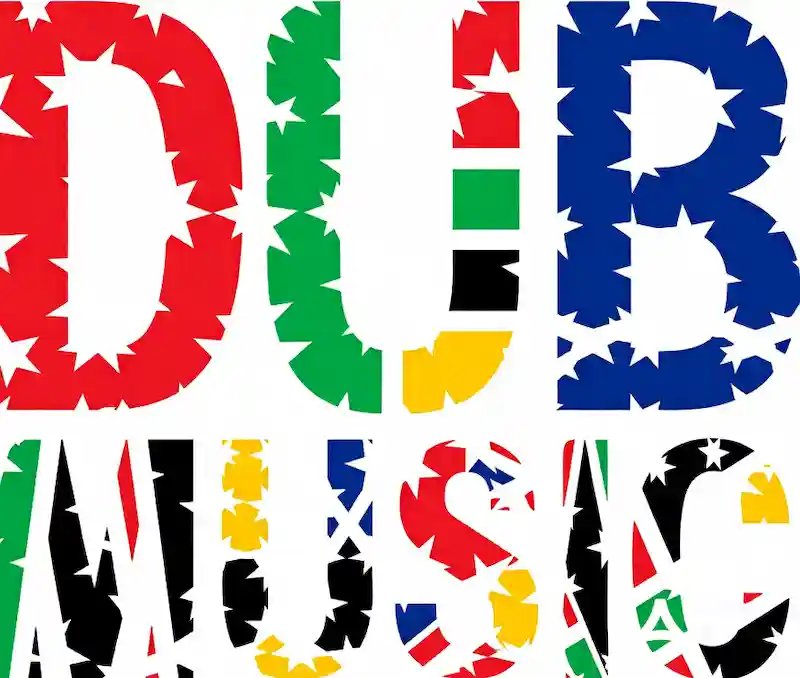
Dub, a subgenre of reggae, turns the studio into an instrument through creative effects. This innovative approach to sound manipulation allows for unique and expansive reggae sounds that are integral to the genre.
Signature Dub Effects:
- Delay
- Spring Reverb
- Echo
- Tape manipulation
Pioneers like King Tubby and Lee “Scratch” Perry used these tools to reshape reggae tracks into new sonic experiences, making the studio itself an active instrumental reggae component. This highlights how even studio techniques can be considered part of the expanded family of reggae instruments.

How Reggae Instruments Influence the Genre’s Feel and Message
Instrumentation in reggae doesn’t just carry melody and rhythm—it profoundly reinforces the cultural and emotional message. The careful selection and unique application of reggae musical instruments deeply influence the genre’s atmosphere and storytelling.
For example, the sparse, haunting echo of dub effects often mirrors themes of mysticism or resistance. The warm, rounded tone of the reggae bass line reflects themes of unity and grounding. Even skank guitar reggae’s rapid off-beat chords can express carefree delight or playful rebellion.
In roots reggae, the minor key often dominates, contributing to a somber, reflective mood. In contrast, ska’s quick tempo and horn bursts energize the listener, evoking celebration. Instrumentation is more than sound—it’s storytelling in vibration, making each music instrument reggae uses a vital storyteller in its unique way.
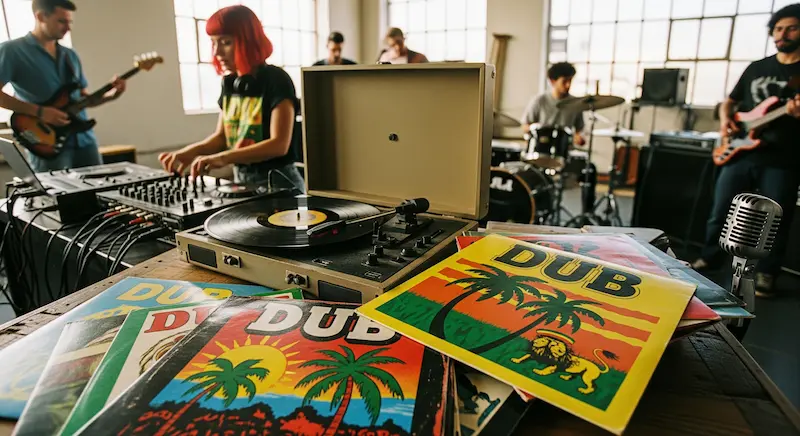
Psychological and Physiological Effects of Reggae Instruments
The impact of reggae instruments extends beyond the ears. Research and anecdotal evidence both suggest that reggae’s sonic patterns, created by these specific reggae instruments, can influence the body and mind in profound ways.
Low-frequency bass reggae lines have been shown to slow heart rates and induce a calming effect. Reggae drums and keys’ rhythmic repetition induces a trance-like state that promotes mindfulness or even meditative awareness. The continued usage of percussion instruments, such as the Nyabinghi drums, in spiritual and therapeutic rituals attests to their profound influence.
The syncopated rhythms of reggae—where emphasis lands on unexpected beats—activate both hemispheres of the brain, fostering engagement and alertness. In music therapy, such patterns have been used to reduce anxiety and improve emotional regulation. Many reggae songs embody these healing properties, largely due to their unique instrumentation.
Reggae Instruments Around the World: Global Adaptations
As reggae spread globally, so did its instrumentation—often fused with local musical instruments reggae artists found in new regions. These modifications show the adaptability of reggae instruments and emphasize the genre’s global reach and diversity.
In Latin America, especially in countries like Panama and Colombia, reggae en Español often incorporates traditional nylon-string guitars and Latin percussion instruments. African reggae bands in Ghana or Nigeria blend reggae with talking drums, balafon, or kora.
In India and Southeast Asia, modern reggae fusion artists introduce sitar, tabla, or bamboo flutes to blend ancient traditions with the reggae groove. Even in Eastern Europe and Russia, accordions or traditional string instruments are added to the reggae framework, reflecting local reggae culture while preserving reggae’s backbone. These fusions expand the definition of what constitutes reggae instruments in a global context.
Behind the Mix: The Role of the Sound Engineer in Reggae
The iconic reggae sound doesn’t happen by accident. Behind every great reggae recording or live performance is a skilled sound engineer shaping the dynamic flow of the reggae instruments.
In dub, especially, the engineer becomes part of the performance—muting individual reggae instruments, triggering echoes, riding faders in real time. In a live show, they balance bass-heavy frequencies with crisp vocals, keeping the groove intact across unpredictable venues. This careful manipulation of the individual reggae instrument sounds is essential for effective reggae music production.
Reggae’s reliance on deep reggae bass, delicate skank reggae guitars, and shimmering effects means every reggae musical instrument needs distinct space in the mix. A good engineer knows when to let a bass line rumble, when to dry out a vocal, or when to let the reverb bloom. The engineer acts as a conductor for the symphony of reggae instruments.
From Nyabinghi to Dub: The Historical Roots of Reggae Instruments
The instrumentation of reggae music draws from a deep historical well, blending African tradition, Caribbean folk, and Western technology. The very foundation of reggae instruments is rooted in this diverse history. Reggae’s percussive backbone, especially Nyabinghi drums, evolved from Afro-Jamaican spiritual ceremonies.
As colonial influence brought European instruments like guitars, horns, and pianos to the island, Jamaican musicians adopted and adapted them, transforming them into what we now recognize as essential reggae instruments. The fusion of these influences in post-independence Jamaica during the 1960s led to the emergence of ska and rocksteady, both precursors to reggae.
By the 1970s, the rise of Rastafari spirituality and sound system culture gave birth to roots reggae and dub. Engineers like King Tubby began treating the studio as an instrument, shaping reggae with echo, reverb, and innovative mixing. These developments firmly established reggae’s distinct instrumental identity and the foundational characteristics of its reggae instruments.
Inside the Studio: Gear and Technology Behind the Reggae Sound
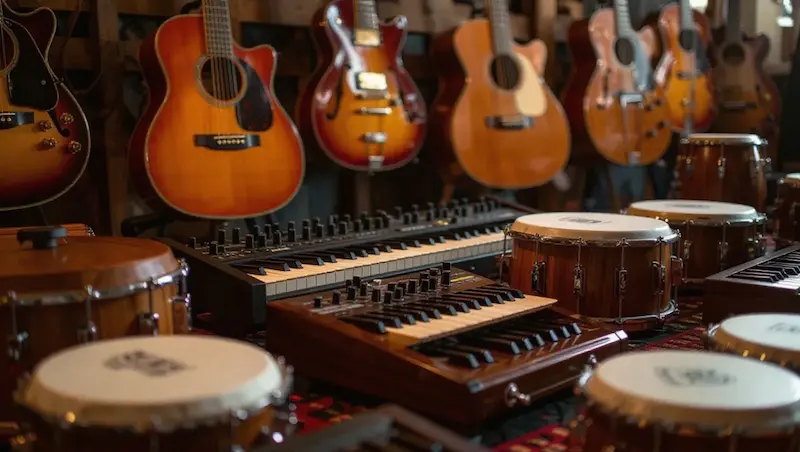
Reggae isn’t just created on stage—it’s crafted in the studio with iconic gear that became part of the genre’s DNA. This is where the unique reggae sounds created by its reggae instruments are truly shaped and refined.
Classic reggae studio gear includes:
- Roland Space Echo (RE-201)
- Spring reverbs
- Analog mixing desks
- Tape delays
Producers like Scientist and Mad Professor used dub effects to stretch and warp time, isolating individual reggae instruments, and making drums echo into infinity.
Today, digital plugins recreate these effects in DAWs (Digital Audio Workstations) like Logic Pro and Ableton Live. Modern reggae producers still rely on delays, filters, and sub-bass enhancement to achieve that hypnotic groove, which is often found in new reggae music and latest reggae music. The use of a reggae drum machine can also be prevalent in modern production, further expanding the palette of reggae instruments.
Icons of Sound: The Musicians Who Shaped Reggae’s Instrumental Style
Many of reggae’s most memorable sounds were forged by musicians who became legends in their own right, defining how reggae instruments are played. These artists created some of the best reggae music and top reggae music through their mastery.
Notable Instrumentalists:
- Aston “Family Man” Barrett (Bass): Defined the role of bass in reggae as melodic, deep, and spiritual, making it a lead reggae instrument.
- Drummer Carlton Barrett: Solidified the drum kit’s position as a fundamental reggae instrument by inventing the One Drop beat and revolutionizing reggae drumming.
- Jackie Mittoo, a founding member of the Skatalites and a session keyboardist for Studio One, helped to shape the rhythmic and melodic elements of this reggae instrument.
- Ernest Ranglin, a guitarist, combined ska and jazz to create reggae guitar, inspiring future generations and demonstrating the instrument’s adaptability.
These musicians added to the rich tapestry of reggae instrumentals by being not only masters of their particular instruments but also trailblazers in defining the sound and feel of reggae. They are responsible for much of the popular reggae music we hear today.
Instruments by Subgenre: How the Sound Changes
Reggae isn’t a monolith. Different subgenres tweak the use of reggae instruments to reflect cultural and rhythmic shifts, showcasing the genre’s adaptability.
- Ska: Fast tempo, heavy use of horns, walking bass lines. The prominent horns are key reggae instruments in this subgenre.
- Rocksteady: Slower than ska, more romantic, with tighter guitar and harmony vocals.
- Roots Reggae: Spiritual themes, prominent basslines, Nyabinghi percussion. These traditional reggae instruments are essential here.
- Dub: Stripped-back tracks with effects and studio manipulation, focusing on how reggae instruments are treated through sound engineering. This is primarily instrumental reggae.
- Dancehall: Digital drums, autotuned vocals, synth bass. These modern electronic reggae instruments define the sound of reggae dancehall music.
- Reggaeton: Latin fusion with dembow rhythm, heavy synths, minimal guitar. This often crosses into reggae pop music, incorporating a different set of reggae instruments.
- Lovers Rock: Smooth grooves, melodic vocals, lush instrumentation.
Each subgenre carefully shapes its choice and application of reggae instruments to match its vibe, culture, and audience. This evolution keeps reggae music fresh and relevant, constantly producing new reggae songs.
Building a Reggae Band: Typical Setup
If you’re forming or analyzing a reggae band, here’s a common configuration of the essential reggae music instruments that typically make up the group:
| Role | Instrument |
| Drummer | Drum kit (a core reggae instrument) |
| Bassist | Electric bass guitar (the backbone reggae instrument) |
| Guitarist | Rhythm guitar (skank style – a unique reggae instrument technique) |
| Keyboardist | Organ or synth (reggae instruments that add bubble and stabs) |
| Percussionist | Congas, shakers, tambourines (percussion instrument providing rhythm) |
| Horn Section | Trumpet, saxophone, trombone (melodic reggae instruments) |
| Lead Vocalist | Voice (melodic and rhythmic lead – a crucial reggae instrument) |
| Backup Singers | Harmonies |
| Dub Engineer | Studio/live effects (optional – the studio as a reggae instrument) |
Export to Sheets
Try This at Home: DIY Reggae Instrument Setup
Want to create your own reggae sound at home? Here’s a basic setup for creating your own reggae instrumental using readily available tools:
Budget-Friendly Tools:
- Digital Audio Workstations or DAW (Ableton Live Lite or GarageBand)
- Free reggae drum loops
- Bass Virtual Studio Technology (VST) with deep EQ
- Spring reverb & delay plugins
- MIDI keyboard for bubble/stabs
Add a skank guitar sample and some conga loops, and you’re ready to build a riddim and produce your own reggae songs! You can even simulate a reggae drum machine for digital rhythms, expanding your home studio’s set of virtual reggae instruments.
Final Thoughts – Reggae’s Instrumental Soul
More than just tools, reggae instruments are symbols of rhythm, culture, and consciousness. From the spiritual echoes of Nyabinghi drums to the futuristic dub effects of the studio, every layer plays a role in this global music phenomenon. These are the reggae instruments’ that unmistakably distinguish reggae from other styles of music.
Understanding the instruments behind reggae gives you a deeper connection to the genre’s soul and opens your ears to the beauty in its simplicity and power. It also helps to appreciate the evolution from reggae pop influences to traditional roots, all driven by the innovative use of reggae instruments.
Explore More:
- The Function of Bass in Reggae Music
- What Is Reggae? A Music Guide
- Top Reggae Artists of All Time
- Reggae Dance Styles – From Skank to Whining
- Reggae Genres Explained

